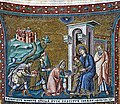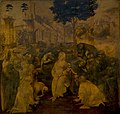Adoration of the Magi
The adoration of the baby Jesus by the three wise men , or in short: adoration of the kings , is a motif known in Christian art since late antiquity . Mary , Joseph and the baby Jesus are depicted , to whom the three wise men from the East pay homage with the three gifts gold , frankincense and myrrh . In the background you can often see ox and donkey , parts of the caravan of kings on the edge of the picture and the star of Bethlehem in the sky . In rare cases, the adoration of the kings and the adoration of the shepherds are combined in one scene.
The adoration of a child in a manger by high-ranking or educated persons such as kings, magicians, astrologers or wise men underlines the higher-ranking position of Jesus. In addition, the three wise men are seen as representatives of the non-Jewish world, often representing the three continents known at the time, Europe, Asia and Africa. The motif of the three ages also flows into some depictions. The presented gifts of gold, frankincense and myrrh are interpreted in different ways. Their triad motivates the three wise men from the Orient presented. In the legend, the skilled magicians are embodied as three kings who are venerated in the Catholic Church as the Three Kings .
Adoration of the baby Jesus by three uncrowned magicians or magicians; Sarcophagus relief (4th century)
Adoration of the Magi; Byzantine mosaic in Santa Maria in Trastevere in Rome (around 1250)
Adoration of the kings; Fresco in the Scrovegni Chapel by Giotto di Bondone (around 1303)
Adoration of the kings; Panel painting (Strozzi Altar) by Gentile da Fabriano (around 1423)
Adoration of the kings ; Panel painting (Zanobi altar) by Sandro Botticelli (around 1476)
Adoration of the kings ; Oil sketch by Leonardo da Vinci (around 1481)
Adoration of the kings ; Oil painting by Albrecht Dürer (1504)
Adoration of the kings; Oil painting by Jacopo Bassano (around 1563/4)
Adoration of the Magi refers to the legendary motif of a depiction of three kings worshiping the newborn child Jesus, for example the Adoration of the Kings by Albrecht Dürer ; In the Italian cultural area, the term Adorazione dei Magi is common. A number of depictions of this motif have survived, especially from the Renaissance , including various Adorazione dei Magi by Giotto di Bondone , Gentile da Fabriano , Sandro Botticelli , Leonardo da Vinci , Filippino Lippi and others. From the Spanish area there are depictions of the adoring kings or magicians, an Adoración de los Reyes Magos , etc. a. known from El Greco and Velázquez ; Dutch painters such as Hieronymus Bosch and Peter Paul Rubens have also translated interpretations of this motif into paintings. In the Middle Ages, the term “magician” was also used to describe astronomers and astrologers .
Bible text
The motif goes back to the Gospel of Matthew ( Mt 2,1-12 EU ), where it says:
“When Jesus was born in Bethlehem in Judea at the time of King Herod, magicians from the east came to Jerusalem and asked: Where is the newborn King of the Jews? We have seen his star rise and have come to pay homage to him. When King Herod heard this, he was terrified, and all Jerusalem with him. He summoned all the chief priests and scribes of the people and asked them where the Messiah was to be born. They answered him, In Bethlehem in Judea; for so it is with the prophet: You, Bethlehem in the region of Judah, are by no means the least important of the leading cities of Judah; for out of you a prince will come forth, the shepherd of my people Israel. Then Herod secretly called the magicians and asked them to tell him exactly when the star had appeared. Then he sent her to Bethlehem and said: Go and find out carefully where the child is; and when you have found it, tell me, so that I too may go and pay homage to him. After these words from the king, they set off. And the star that they had seen rise went before them to the place where the child was; there he stopped. When they saw the star, they were filled with very great joy. They went into the house and saw the child and Mary, his mother; then they fell down and paid homage to him. Then they took out their treasures and offered him gold, frankincense and myrrh as gifts. But because they were commanded in a dream not to return to Herod, they went home to their country another way. "
literature
- Stephan Waetzoldt: Drei Könige , in: Reallexikon zur Deutschen Kunstgeschichte , Vol. 4, 1955, Sp. 476–501







